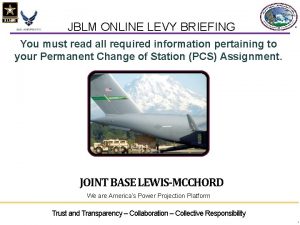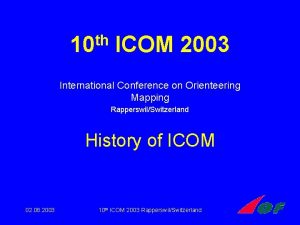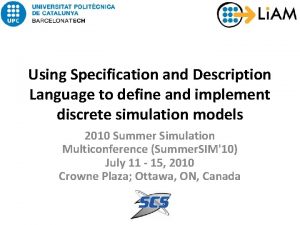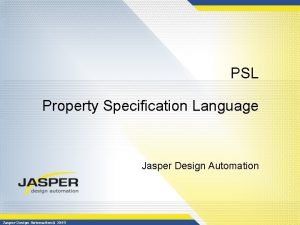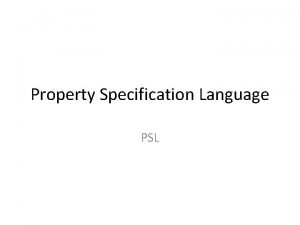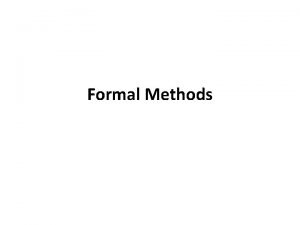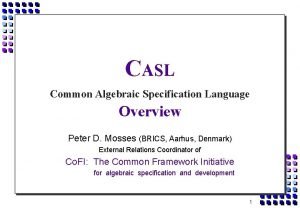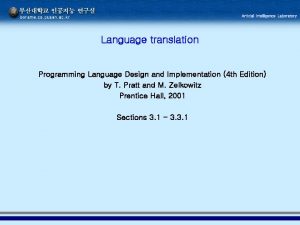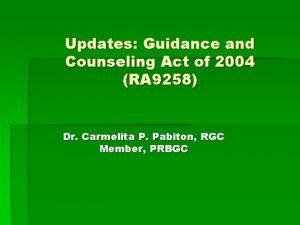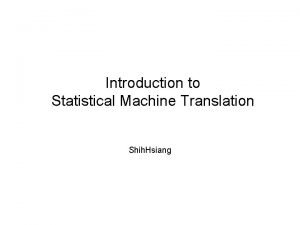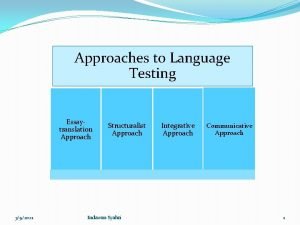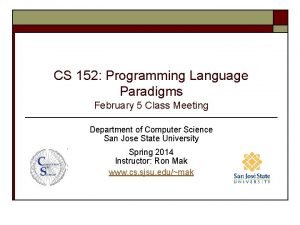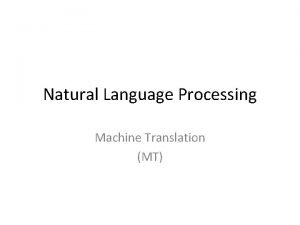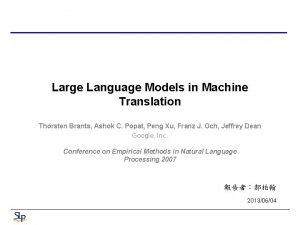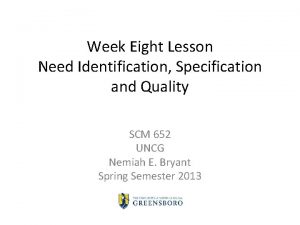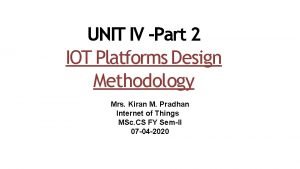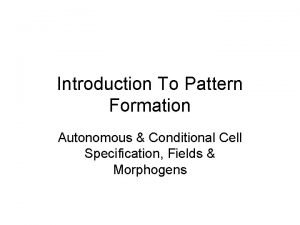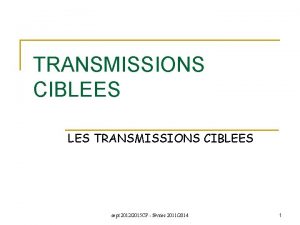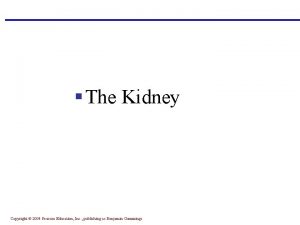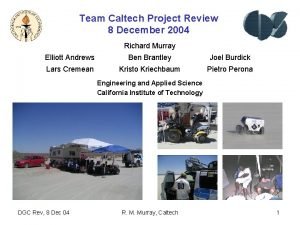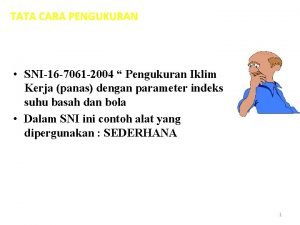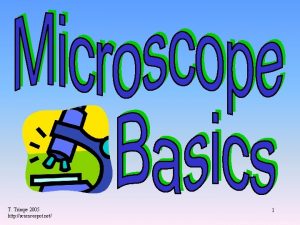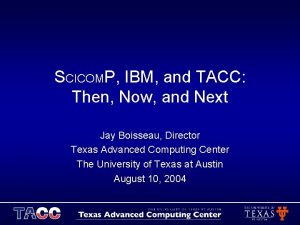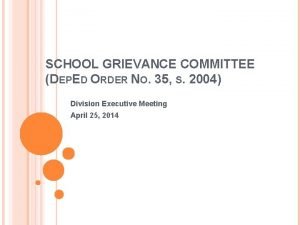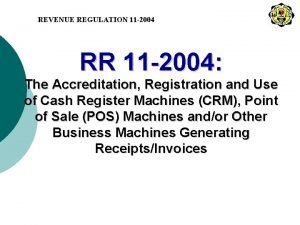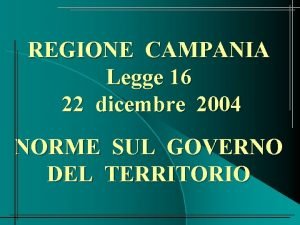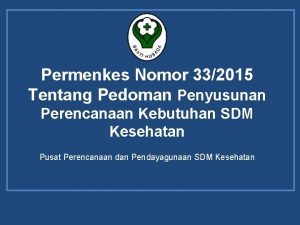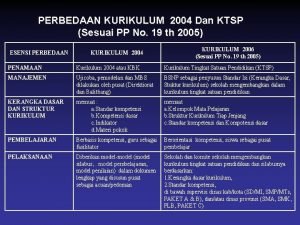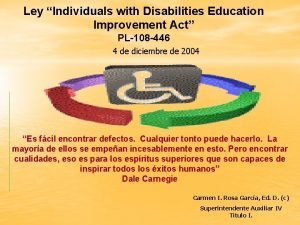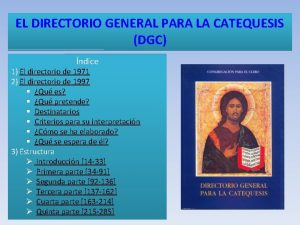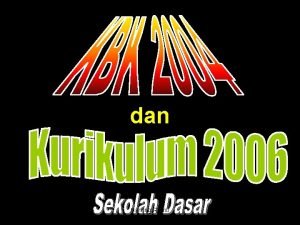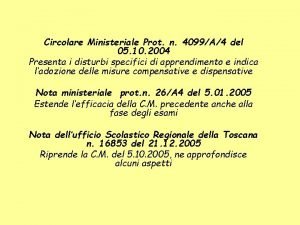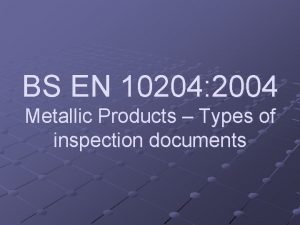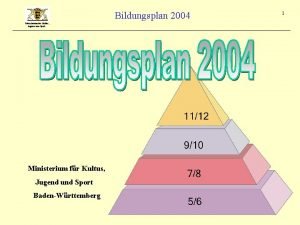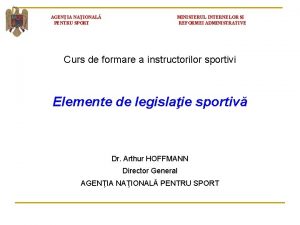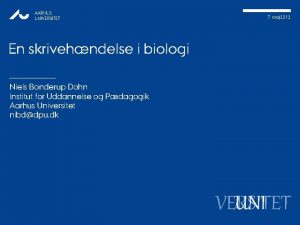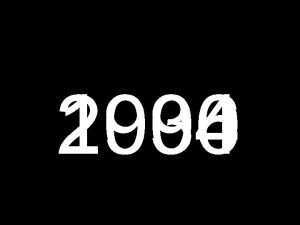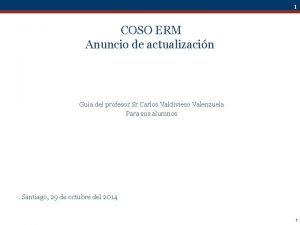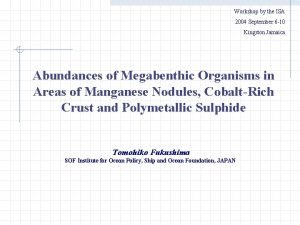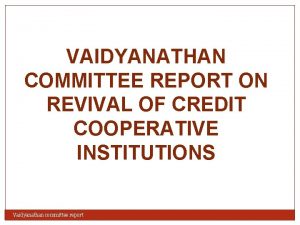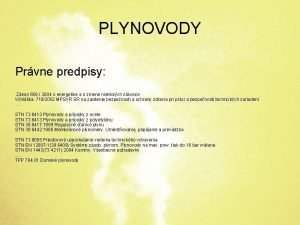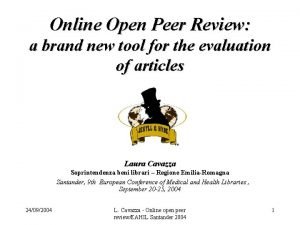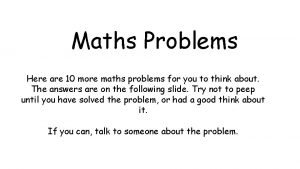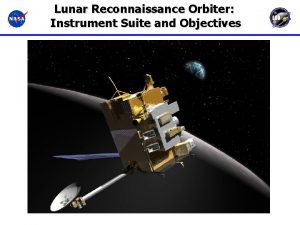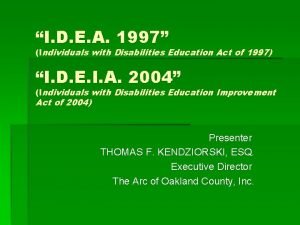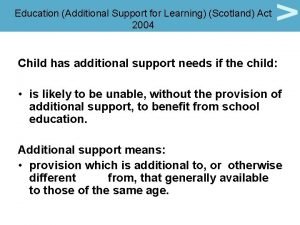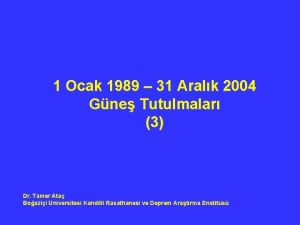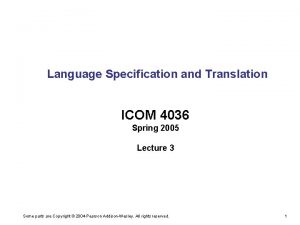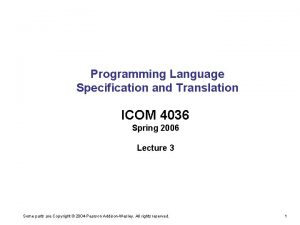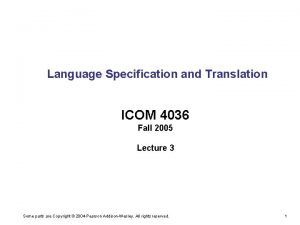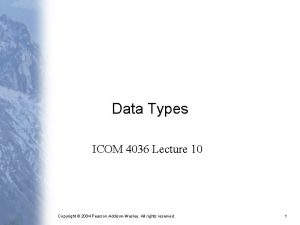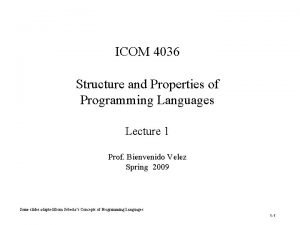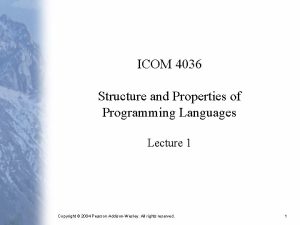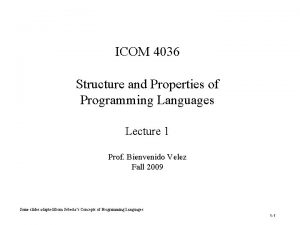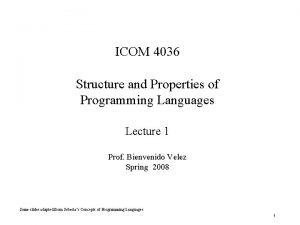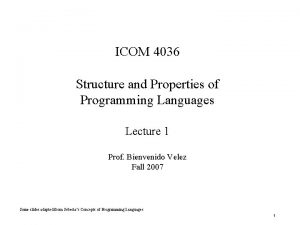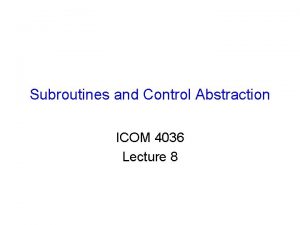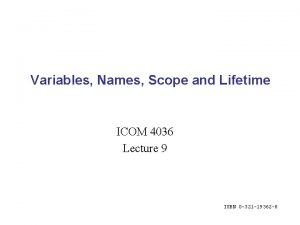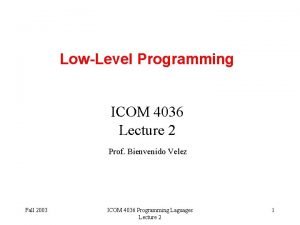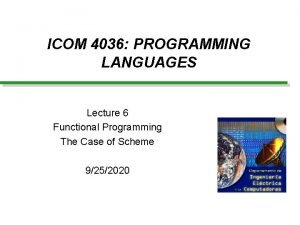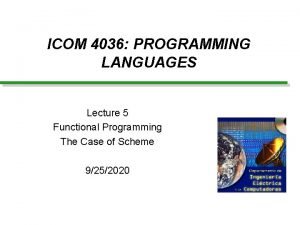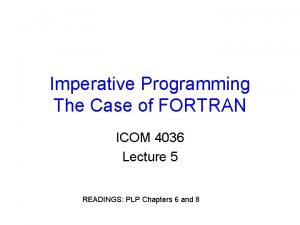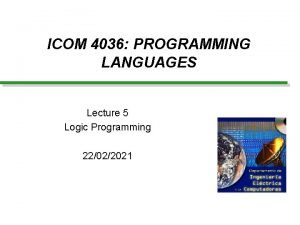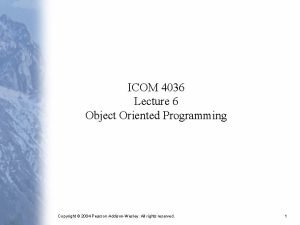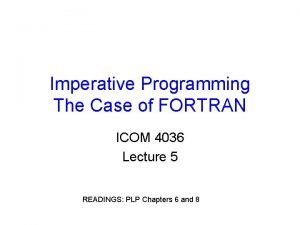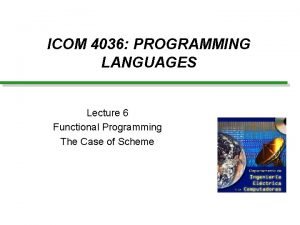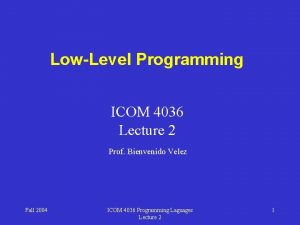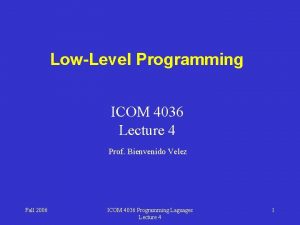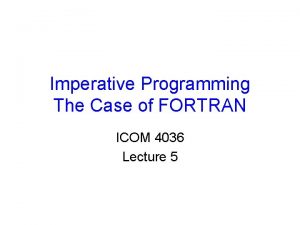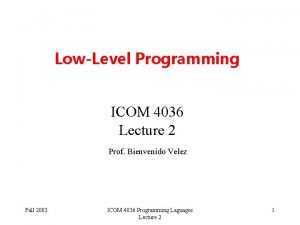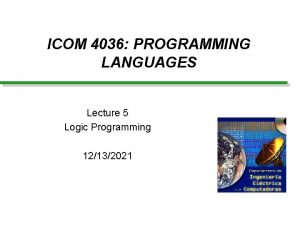Language Specification and Translation ICOM 4036 Spring 2004


































































![Bottom-up Parsing • Parser actions (continued): – If ACTION[Sm, ai] = Accept, the parse Bottom-up Parsing • Parser actions (continued): – If ACTION[Sm, ai] = Accept, the parse](https://slidetodoc.com/presentation_image/31f10f08dc4f1d42e7c2defbcf0746a0/image-67.jpg)














- Slides: 81

Language Specification and Translation ICOM 4036 Spring 2004 Lecture 3 Copyright © 2004 Pearson Addison-Wesley. All rights reserved. 1

Language Specification and Translation Topics • • Structure of a Compiler Lexical Specification and Scanning Syntactic Specification and Parsing Semantic Specification and Analysis Copyright © 2004 Pearson Addison-Wesley. All rights reserved. 2

Syntax versus Semantics • Syntax - the form or structure of the expressions, statements, and program units • Semantics - the meaning of the expressions, statements, and program units Copyright © 2004 Pearson Addison-Wesley. All rights reserved. 3

The Structure of a Compiler 1. 2. 3. 4. 5. Lexical Analysis Parsing Semantic Analysis Optimization Code Generation The first 3, at least, can be understood by analogy to how humans comprehend English. Copyright © 2004 Pearson Addison-Wesley. All rights reserved. 4

A Prototypical Compiler source Scanner tokens Parser AST Semantic Analysis IL Optimizer IL Code Generator Copyright © 2004 Pearson Addison-Wesley. All rights reserved. exe 5

Introduction • Reasons to separate compiler in phases: – Simplicity - less complex approaches can be used for lexical analysis; separating them simplifies the parser – Efficiency - separation allows optimization of the lexical analyzer – Portability - parts of the lexical analyzer may not be portable, but the parser always is portable Copyright © 2004 Pearson Addison-Wesley. All rights reserved. 6

Lexical Analysis • First step: recognize words. – Smallest unit above letters This is a sentence. • Note the – Capital “T” (start of sentence symbol) – Blank “ “ (word separator) – Period “. ” (end of sentence symbol) Copyright © 2004 Pearson Addison-Wesley. All rights reserved. 7

Lexical Analysis • Lexical analysis is not trivial. Consider: ist his ase nte nce • Plus, programming languages are typically more cryptic than English: *p->f ++ = -. 12345 e-5 Copyright © 2004 Pearson Addison-Wesley. All rights reserved. 8

Lexical Analysis • Lexical analyzer divides program text into “words” or “tokens” if x == y then z = 1; else z = 2; • Units: if, x, ==, y, then, z, =, 1, ; , else, z, =, 2, ; Copyright © 2004 Pearson Addison-Wesley. All rights reserved. 9

Lexical Analysis • A lexical analyzer is a pattern matcher for character strings • A lexical analyzer is a “front-end” for the parser • Identifies substrings of the source program that belong together - lexemes – Lexemes match a character pattern, which is associated with a lexical category called a token – sum is a lexeme; its token may be IDENT Copyright © 2004 Pearson Addison-Wesley. All rights reserved. 10

Lexical Analysis • The lexical analyzer is usually a function that is called by the parser when it needs the next token • Three approaches to building a lexical analyzer: – Write a formal description of the tokens and use a software tool that constructs table-driven lexical analyzers given such a description – Design a state diagram that describes the tokens and write a program that implements the state diagram – Design a state diagram that describes the tokens and handconstruct a table-driven implementation of the state diagram • We only discuss approach 2 State diagram = Finite State Machine Copyright © 2004 Pearson Addison-Wesley. All rights reserved. 11

Lexical Analysis • State diagram design: – A naïve state diagram would have a transition from every state on every character in the source language - such a diagram would be very large! • In many cases, transitions can be combined to simplify the state diagram – When recognizing an identifier, all uppercase and lowercase letters are equivalent • Use a character class that includes all letters – When recognizing an integer literal, all digits are equivalent - use a digit class Copyright © 2004 Pearson Addison-Wesley. All rights reserved. 12

Lexical Analysis • Reserved words and identifiers can be recognized together (rather than having a part of the diagram for each reserved word) – Use a table lookup to determine whether a possible identifier is in fact a reserved word Copyright © 2004 Pearson Addison-Wesley. All rights reserved. 13

Lexical Analysis • Convenient utility subprograms: – get. Char - gets the next character of input, puts it in next. Char, determines its class and puts the class in char. Class – add. Char - puts the character from next. Char into the place the lexeme is being accumulated, lexeme – lookup - determines whether the string in lexeme is a reserved word (returns a code) Copyright © 2004 Pearson Addison-Wesley. All rights reserved. 14

State Diagram Copyright © 2004 Pearson Addison-Wesley. All rights reserved. 15

Lexical Analysis • Implementation (assume initialization): int lex() { get. Char(); switch (char. Class) { case LETTER: add. Char(); get. Char(); while (char. Class == LETTER || char. Class == DIGIT) { add. Char(); get. Char(); } return lookup(lexeme); break; … Copyright © 2004 Pearson Addison-Wesley. All rights reserved. 16

Lexical Analysis … case DIGIT: add. Char(); get. Char(); while (char. Class == DIGIT) { add. Char(); get. Char(); } return INT_LIT; break; } /* End of switch */ } /* End of function lex */ Copyright © 2004 Pearson Addison-Wesley. All rights reserved. 17

Parsing • Once words are understood, the next step is to understand sentence structure • Parsing = Diagramming Sentences – The diagram is a tree Copyright © 2004 Pearson Addison-Wesley. All rights reserved. 18

Diagramming a Sentence Thi s line article is noun verb a longer article adjective subject sentence noun object sentence Copyright © 2004 Pearson Addison-Wesley. All rights reserved. 19

Parsing Programs • Parsing program expressions is the same • Consider: If x == y then z = 1; else z = 2; • Diagrammed: x == y z 1 z 2 relation assign predicate then-stmt else-stmt if-then-else Copyright © 2004 Pearson Addison-Wesley. All rights reserved. 20

Describing Syntax • A sentence is a string of characters over some alphabet • A language is a set of sentences • A lexeme is the lowest level syntactic unit of a language (e. g. , *, sum, begin) • A token is a category of lexemes (e. g. , identifier) Copyright © 2004 Pearson Addison-Wesley. All rights reserved. 21

Describing Syntax • Formal approaches to describing syntax: – Recognizers - used in compilers (we will look at in Chapter 4) – Generators – generate the sentences of a language (what we'll study in this chapter) Copyright © 2004 Pearson Addison-Wesley. All rights reserved. 22

Formal Methods of Describing Syntax • Context-Free Grammars – Developed by Noam Chomsky in the mid-1950 s – Language generators, meant to describe the syntax of natural languages – Define a class of languages called context-free languages Copyright © 2004 Pearson Addison-Wesley. All rights reserved. 23

Formal Methods of Describing Syntax • Backus-Naur Form (1959) – Invented by John Backus to describe Algol 58 – BNF is equivalent to context-free grammars – A metalanguage is a language used to describe another language. – In BNF, abstractions are used to represent classes of syntactic structures--they act like syntactic variables (also called nonterminal symbols) Copyright © 2004 Pearson Addison-Wesley. All rights reserved. 24

Backus-Naur Form (1959) <while_stmt> while ( <logic_expr> ) <stmt> • This is a rule; it describes the structure of a while statement Copyright © 2004 Pearson Addison-Wesley. All rights reserved. 25

Formal Methods of Describing Syntax • A rule has a left-hand side (LHS) and a right-hand side (RHS), and consists of terminal and nonterminal symbols • A grammar is a finite nonempty set of rules • An abstraction (or nonterminal symbol) can have more than one RHS <stmt> <single_stmt> | begin <stmt_list> end Copyright © 2004 Pearson Addison-Wesley. All rights reserved. 26

Formal Methods of Describing Syntax • Syntactic lists are described using recursion <ident_list> ident | ident, <ident_list> • A derivation is a repeated application of rules, starting with the start symbol and ending with a sentence (all terminal symbols) Copyright © 2004 Pearson Addison-Wesley. All rights reserved. 27

Formal Methods of Describing Syntax • An example grammar: <program> <stmts> <stmt> | <stmt> ; <stmts> <stmt> <var> = <expr> <var> a | b | c | d <expr> <term> + <term> | <term> <var> | const Copyright © 2004 Pearson Addison-Wesley. All rights reserved. 28

Formal Methods of Describing Syntax • An example derivation: <program> => <stmts> => <stmt> => <var> = <expr> => a = <term> + <term> => a = <var> + <term> => a = b + const Copyright © 2004 Pearson Addison-Wesley. All rights reserved. 29

Derivation • Every string of symbols in the derivation is a sentential form • A sentence is a sentential form that has only terminal symbols • A leftmost derivation is one in which the leftmost nonterminal in each sentential form is the one that is expanded • A derivation may be neither leftmost nor rightmost Copyright © 2004 Pearson Addison-Wesley. All rights reserved. 30

Parse Tree • A hierarchical representation of a derivation <program> <stmts> <stmt> <var> = <expr> a <term>+ <term> <var> const b Copyright © 2004 Pearson Addison-Wesley. All rights reserved. 31

Formal Methods of Describing Syntax • A grammar is ambiguous iff it generates a sentential form that has two or more distinct parse trees Copyright © 2004 Pearson Addison-Wesley. All rights reserved. 32

An Ambiguous Expression Grammar <expr> <op> <expr> | const <op> / | <expr> <op> <expr><op><expr> const - const / Copyright © 2004 Pearson Addison-Wesley. All rights reserved. <expr><op><expr> const - const / const 33

An Unambiguous Expression Grammar • If we use the parse tree to indicate precedence levels of the operators, we cannot have ambiguity <expr> - <term> | <term> / const | const <expr> - <term> / const Copyright © 2004 Pearson Addison-Wesley. All rights reserved. const 34

Formal Methods of Describing Syntax Derivation: <expr> => <expr> - <term> => <term> - <term> => const - <term> / const => const - const / const Copyright © 2004 Pearson Addison-Wesley. All rights reserved. 35

Formal Methods of Describing Syntax • Operator associativity can also be indicated by a grammar <expr> -> <expr> + <expr> | const (ambiguous) <expr> -> <expr> + const | const (unambiguous) <expr> + const Copyright © 2004 Pearson Addison-Wesley. All rights reserved. 36

Formal Methods of Describing Syntax • Extended BNF (just abbreviations): – Optional parts are placed in brackets ([ ]) <proc_call> -> ident [ ( <expr_list>)] – Put alternative parts of RHSs in parentheses and separate them with vertical bars <term> -> <term> (+ | -) const – Put repetitions (0 or more) in braces ({ }) <ident> -> letter {letter | digit} Copyright © 2004 Pearson Addison-Wesley. All rights reserved. 37

BNF and EBNF • BNF: <expr> + <term> | <expr> - <term> | <term> * <factor> | <term> / <factor> | <factor> • EBNF: <expr> <term> {(+ | -) <term>} <term> <factor> {(* | /) <factor>} Copyright © 2004 Pearson Addison-Wesley. All rights reserved. 38

The Parsing Problem • Goals of the parser, given an input program: – Find all syntax errors; for each, produce an appropriate diagnostic message, and recover quickly – Produce the parse tree, or at least a trace of the parse tree, for the program Copyright © 2004 Pearson Addison-Wesley. All rights reserved. 39

The Parsing Problem • Two categories of parsers – Top down - produce the parse tree, beginning at the root • Order is that of a leftmost derivation – Bottom up - produce the parse tree, beginning at the leaves • Order is that of the reverse of a rightmost derivation • Parsers look only one token ahead in the input Copyright © 2004 Pearson Addison-Wesley. All rights reserved. 40

The Parsing Problem • Top-down Parsers – Given a sentential form, x. A , the parser must choose the correct A-rule to get the next sentential form in the leftmost derivation, using only the first token produced by A • The most common top-down parsing algorithms: – Recursive descent - a coded implementation – LL parsers - table driven implementation Copyright © 2004 Pearson Addison-Wesley. All rights reserved. 41

The Parsing Problem • Bottom-up parsers – Given a right sentential form, , determine what substring of is the right-hand side of the rule in the grammar that must be reduced to produce the previous sentential form in the right derivation – The most common bottom-up parsing algorithms are in the LR family Copyright © 2004 Pearson Addison-Wesley. All rights reserved. 42

The Parsing Problem • The Complexity of Parsing – Parsers that work for any unambiguous grammar are complex and inefficient ( O(n 3), where n is the length of the input ) – Compilers use parsers that only work for a subset of all unambiguous grammars, but do it in linear time ( O(n), where n is the length of the input ) Copyright © 2004 Pearson Addison-Wesley. All rights reserved. 43

Recursive-Descent Parsing • Recursive Descent Process – There is a subprogram for each nonterminal in the grammar, which can parse sentences that can be generated by that nonterminal – EBNF is ideally suited for being the basis for a recursive-descent parser, because EBNF minimizes the number of nonterminals Copyright © 2004 Pearson Addison-Wesley. All rights reserved. 44

Recursive-Descent Parsing • A grammar for simple expressions: <expr> <term> {(+ | -) <term>} <term> <factor> {(* | /) <factor>} <factor> id | ( <expr> ) Copyright © 2004 Pearson Addison-Wesley. All rights reserved. 45

Recursive-Descent Parsing • Assume we have a lexical analyzer named lex, which puts the next token code in next. Token • The coding process when there is only one RHS: – For each terminal symbol in the RHS, compare it with the next input token; if they match, continue, else there is an error – For each nonterminal symbol in the RHS, call its associated parsing subprogram Copyright © 2004 Pearson Addison-Wesley. All rights reserved. 46

Recursive-Descent Parsing /* Function expr Parses strings in the language generated by the rule: <expr> → <term> {(+ | -) <term>} */ void expr() { /* Parse the first term */ term(); … Copyright © 2004 Pearson Addison-Wesley. All rights reserved. 47

Recursive-Descent Parsing /* As long as the next token is + or -, call lex to get the next token, and parse the next term */ while (next. Token == PLUS_CODE || next. Token == MINUS_CODE){ lex(); term(); } } • This particular routine does not detect errors • Convention: Every parsing routine leaves the next token in next. Token Copyright © 2004 Pearson Addison-Wesley. All rights reserved. 48

Recursive-Descent Parsing • A nonterminal that has more than one RHS requires an initial process to determine which RHS it is to parse – The correct RHS is chosen on the basis of the next token of input (the lookahead) – The next token is compared with the first token that can be generated by each RHS until a match is found – If no match is found, it is a syntax error Copyright © 2004 Pearson Addison-Wesley. All rights reserved. 49

Recursive-Descent Parsing /* Function factor Parses strings in the language generated by the rule: <factor> -> id | (<expr>) */ void factor() { /* Determine which RHS */ if (next. Token) == ID_CODE) /* For the RHS id, just call lex */ lex(); Copyright © 2004 Pearson Addison-Wesley. All rights reserved. 50

Recursive-Descent Parsing /* If the RHS is (<expr>) – call lex to pass over the left parenthesis, call expr, and check for the right parenthesis */ else if (next. Token == LEFT_PAREN_CODE) { lex(); expr(); if (next. Token == RIGHT_PAREN_CODE) lex(); else error(); } /* End of else if (next. Token ==. . . */ else error(); /* Neither RHS matches */ } Copyright © 2004 Pearson Addison-Wesley. All rights reserved. 51

Recursive-Descent Parsing • The LL Grammar Class – The Left Recursion Problem • If a grammar has left recursion, either direct or indirect, it cannot be the basis for a top-down parser – A grammar can be modified to remove left recursion Copyright © 2004 Pearson Addison-Wesley. All rights reserved. 52

Recursive-Descent Parsing • The other characteristic of grammars that disallows top-down parsing is the lack of pairwise disjointness – The inability to determine the correct RHS on the basis of one token of lookahead – Def: FIRST( ) = {a | =>* a } (If =>* , is in FIRST( )) Copyright © 2004 Pearson Addison-Wesley. All rights reserved. 53

Recursive-Descent Parsing • Pairwise Disjointness Test: – For each nonterminal, A, in the grammar that has more than one RHS, for each pair of rules, A i and A j, it must be true that FIRST( i) FIRST( j) = • Examples: A a | b. B | c. Ab A a | a. B Copyright © 2004 Pearson Addison-Wesley. All rights reserved. 54

Recursive-Descent Parsing • Left factoring can resolve the problem Replace <variable> identifier | identifier [<expression>] with <variable> identifier <new> | [<expression>] or <variable> identifier [[<expression>]] (the outer brackets are metasymbols of EBNF) Copyright © 2004 Pearson Addison-Wesley. All rights reserved. 55

Bottom-up Parsing • The parsing problem is finding the correct RHS in a right-sentential form to reduce to get the previous right-sentential form in the derivation Copyright © 2004 Pearson Addison-Wesley. All rights reserved. 56

End of ICOM 4036 Fall 2004 Copyright © 2004 Pearson Addison-Wesley. All rights reserved. 57

Bottom-up Parsing • Intuition about handles: – Def: is the handle of the right sentential form = w if and only if S =>*rm Aw =>rm w – Def: is a phrase of the right sentential form if and only if S =>* = 1 A 2 =>+ 1 2 – Def: is a simple phrase of the right sentential form if and only if S =>* = 1 A 2 => 1 2 Copyright © 2004 Pearson Addison-Wesley. All rights reserved. 58

Bottom-up Parsing • Intuition about handles: – The handle of a right sentential form is its leftmost simple phrase – Given a parse tree, it is now easy to find the handle – Parsing can be thought of as handle pruning Copyright © 2004 Pearson Addison-Wesley. All rights reserved. 59

Bottom-up Parsing • Shift-Reduce Algorithms – Reduce is the action of replacing the handle on the top of the parse stack with its corresponding LHS – Shift is the action of moving the next token to the top of the parse stack Copyright © 2004 Pearson Addison-Wesley. All rights reserved. 60

Bottom-up Parsing • Advantages of LR parsers: – They will work for nearly all grammars that describe programming languages. – They work on a larger class of grammars than other bottom-up algorithms, but are as efficient as any other bottom-up parser. – They can detect syntax errors as soon as it is possible. – The LR class of grammars is a superset of the class parsable by LL parsers. Copyright © 2004 Pearson Addison-Wesley. All rights reserved. 61

Bottom-up Parsing • LR parsers must be constructed with a tool • Knuth’s insight: A bottom-up parser could use the entire history of the parse, up to the current point, to make parsing decisions – There were only a finite and relatively small number of different parse situations that could have occurred, so the history could be stored in a parser state, on the parse stack Copyright © 2004 Pearson Addison-Wesley. All rights reserved. 62

Bottom-up Parsing • An LR configuration stores the state of an LR parser (S 0 X 1 S 1 X 2 S 2…Xm. Sm, aiai+1…an$) Copyright © 2004 Pearson Addison-Wesley. All rights reserved. 63

Bottom-up Parsing • LR parsers are table driven, where the table has two components, an ACTION table and a GOTO table – The ACTION table specifies the action of the parser, given the parser state and the next token • Rows are state names; columns are terminals – The GOTO table specifies which state to put on top of the parse stack after a reduction action is done • Rows are state names; columns are nonterminals Copyright © 2004 Pearson Addison-Wesley. All rights reserved. 64

Structure of An LR Parser Copyright © 2004 Pearson Addison-Wesley. All rights reserved. 65

Bottom-up Parsing • Initial configuration: (S 0, a 1…an$) • Parser actions: – If ACTION[Sm, ai] = Shift S, the next configuration is: (S 0 X 1 S 1 X 2 S 2…Xm. Smai. S, ai+1…an$) – If ACTION[Sm, ai] = Reduce A and S = GOTO[Sm-r, A], where r = the length of , the next configuration is (S 0 X 1 S 1 X 2 S 2…Xm-r. Sm-r. AS, aiai+1…an$) Copyright © 2004 Pearson Addison-Wesley. All rights reserved. 66
![Bottomup Parsing Parser actions continued If ACTIONSm ai Accept the parse Bottom-up Parsing • Parser actions (continued): – If ACTION[Sm, ai] = Accept, the parse](https://slidetodoc.com/presentation_image/31f10f08dc4f1d42e7c2defbcf0746a0/image-67.jpg)
Bottom-up Parsing • Parser actions (continued): – If ACTION[Sm, ai] = Accept, the parse is complete and no errors were found. – If ACTION[Sm, ai] = Error, the parser calls an error-handling routine. Copyright © 2004 Pearson Addison-Wesley. All rights reserved. 67

LR Parsing Table Copyright © 2004 Pearson Addison-Wesley. All rights reserved. 68

Bottom-up Parsing • A parser table can be generated from a given grammar with a tool, e. g. , yacc Copyright © 2004 Pearson Addison-Wesley. All rights reserved. 69

Semantic Analysis • Once sentence structure is understood, we can try to understand “meaning” – But meaning is too hard for compilers • Compilers perform limited analysis to catch inconsistencies • Some do more analysis to improve the performance of the program Copyright © 2004 Pearson Addison-Wesley. All rights reserved. 70

Semantic Analysis in English • Example: Jack said Jerry left his assignment at home. What does “his” refer to? Jack or Jerry? • Even worse: Jack said Jack left his assignment at home? How many Jacks are there? Which one left the assignment? Copyright © 2004 Pearson Addison-Wesley. All rights reserved. 71

Semantic Analysis in Programming • Programming languages define strict rules to avoid such ambiguities { • This C++ code prints “ 4”; the inner } definition is used Copyright © 2004 Pearson Addison-Wesley. All rights reserved. int Jack = 3; { int Jack = 4; cout << Jack; } 72

More Semantic Analysis • Compilers perform many semantic checks besides variable bindings • Example: Jack left her homework at home. • A “type mismatch” between her and Jack; we know they are different people – Presumably Jack is male Copyright © 2004 Pearson Addison-Wesley. All rights reserved. 73

Optimization • No strong counterpart in English, but akin to editing • Automatically modify programs so that they – Run faster – Use less memory – In general, conserve some resource • The project has no optimization component Copyright © 2004 Pearson Addison-Wesley. All rights reserved. 74

Optimization Example X = Y * 0 is the same as X = 0 NO! Valid for integers, but not for floating point numbers Copyright © 2004 Pearson Addison-Wesley. All rights reserved. 75

Code Generation • Produces assembly code (usually) • A translation into another language – Analogous to human translation Copyright © 2004 Pearson Addison-Wesley. All rights reserved. 76

Intermediate Languages • Many compilers perform translations between successive intermediate forms – All but first and last are intermediate languages internal to the compiler – Typically there is 1 IL • IL’s generally ordered in descending level of abstraction – Highest is source – Lowest is assembly Copyright © 2004 Pearson Addison-Wesley. All rights reserved. 77

Intermediate Languages (Cont. ) • IL’s are useful because lower levels expose features hidden by higher levels – registers – memory layout – etc. • But lower levels obscure high-level meaning Copyright © 2004 Pearson Addison-Wesley. All rights reserved. 78

Issues • Compiling is almost this simple, but there are many pitfalls. • Example: How are erroneous programs handled? • Language design has big impact on compiler – Determines what is easy and hard to compile – Course theme: many trade-offs in language design Copyright © 2004 Pearson Addison-Wesley. All rights reserved. 79

Compilers Today • The overall structure of almost every compiler adheres to our outline • The proportions have changed since FORTRAN – Early: lexing, parsing most complex, expensive – Today: optimization dominates all other phases, lexing and parsing are cheap Copyright © 2004 Pearson Addison-Wesley. All rights reserved. 80

Trends in Compilation • Compilation for speed is less interesting. But: – scientific programs – advanced processors (Digital Signal Processors, advanced speculative architectures) • Ideas from compilation used for improving code reliability: – memory safety – detecting concurrency errors (data races) –. . . Copyright © 2004 Pearson Addison-Wesley. All rights reserved. 81
 Da form 4036 example
Da form 4036 example Yaesu ftm-400xdr vs icom 5100
Yaesu ftm-400xdr vs icom 5100 Papasys
Papasys ämaps
ämaps Icom model project management
Icom model project management If lclp is negative number, we set the lclp = 0. why?
If lclp is negative number, we set the lclp = 0. why? Natural variations operations management
Natural variations operations management Spring summer fall winter and spring cast
Spring summer fall winter and spring cast Autumn summer winter spring
Autumn summer winter spring What is semantic translation
What is semantic translation Square root function transformations
Square root function transformations Sdl specification and description language
Sdl specification and description language Cisco voice translation rule
Cisco voice translation rule Noun phrases
Noun phrases Property specification language
Property specification language Hardware specification example
Hardware specification example Types of formal methods
Types of formal methods Common algebraic specification language
Common algebraic specification language Language design and translation issues
Language design and translation issues Guidance and counseling act of 2004
Guidance and counseling act of 2004 Language translation algorithm
Language translation algorithm Approaches of language testing
Approaches of language testing Language translation
Language translation Language translation
Language translation Language translation
Language translation Record3d
Record3d Dot translation
Dot translation Large language models in machine translation
Large language models in machine translation Smkvqmuzwv4 -site:youtube.com
Smkvqmuzwv4 -site:youtube.com Need identification and specification
Need identification and specification Participant diary/log
Participant diary/log Analyze vs evaluate
Analyze vs evaluate Domain model specification
Domain model specification Conditional vs autonomous specification
Conditional vs autonomous specification Software requirement analysis and specification
Software requirement analysis and specification Mtved macrocible exemple
Mtved macrocible exemple Renal tubule
Renal tubule Caltech richard murray
Caltech richard murray Tabel rh
Tabel rh T. trimpe 2004 http //sciencespot.net/
T. trimpe 2004 http //sciencespot.net/ Gaatn
Gaatn 2004 dress code
2004 dress code Deped grievance committee
Deped grievance committee Rr 11-2005
Rr 11-2005 Legge regione campania 16/2004
Legge regione campania 16/2004 Permenkes 81 tahun 2004
Permenkes 81 tahun 2004 Perbedaan kurikulum 2004 dan 2013
Perbedaan kurikulum 2004 dan 2013 2004 ford ranger 2.3 firing order
2004 ford ranger 2.3 firing order Age discrimination act 2004
Age discrimination act 2004 Ley idea 2004
Ley idea 2004 Fiona pilkington timeline
Fiona pilkington timeline Lancaster 2004
Lancaster 2004 Anti discrimination act qld
Anti discrimination act qld Directorio general para la catequesis 1971
Directorio general para la catequesis 1971 Hg 974 din 2004
Hg 974 din 2004 Landasan kurikulum 2004
Landasan kurikulum 2004 2004-1948
2004-1948 Circolare miur 4099/a/4 2004
Circolare miur 4099/a/4 2004 Clara morgane 2004
Clara morgane 2004 Bs en 10204
Bs en 10204 Bildungsplan 2004
Bildungsplan 2004 The age discrimination act 2004
The age discrimination act 2004 Ordinul 154 din 2004
Ordinul 154 din 2004 Xxxxxx. me
Xxxxxx. me Maj 2004 biologi
Maj 2004 biologi 2030 - 2004
2030 - 2004 Coso erm 2004
Coso erm 2004 2004 september 6
2004 september 6 Vaidyanathan committee report related to revival of
Vaidyanathan committee report related to revival of 09.02.2004 lunaf
09.02.2004 lunaf Edgar schein 2004
Edgar schein 2004 Ryan ross 2004
Ryan ross 2004 656/2004
656/2004 2004
2004 Roman numerals 2004
Roman numerals 2004 Lunar reconnaissance orbiter
Lunar reconnaissance orbiter Idea 97
Idea 97 Apod nasa gov calendar 1982
Apod nasa gov calendar 1982 Additional support for learning act 2004
Additional support for learning act 2004 Xixx numero romano
Xixx numero romano 2004 tutulmalar
2004 tutulmalar Undang undang nomor 4 tahun 2004
Undang undang nomor 4 tahun 2004
